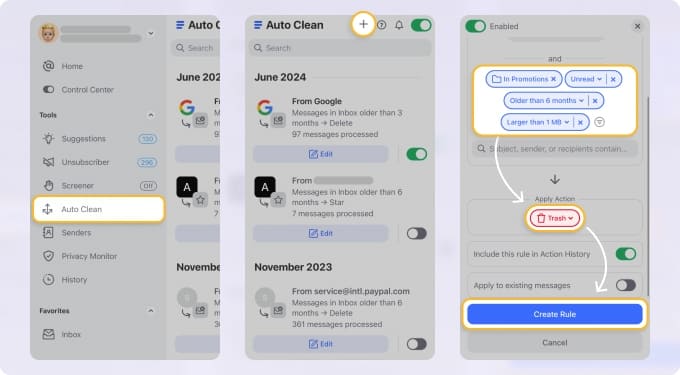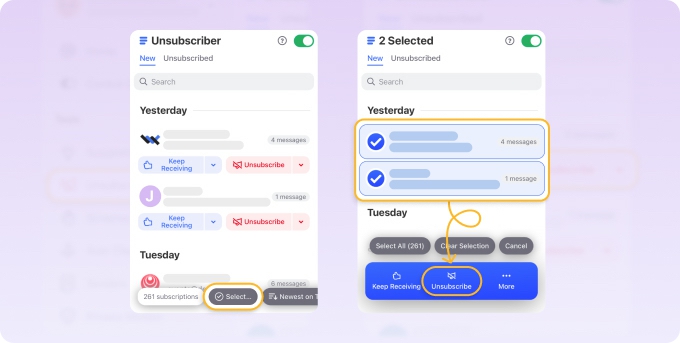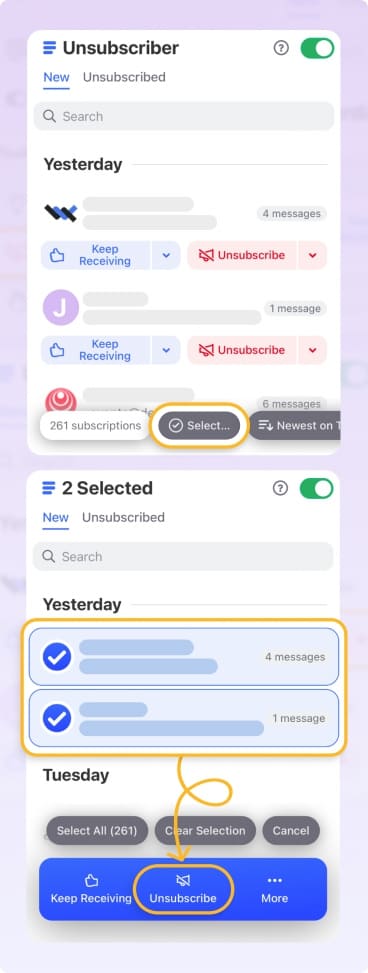Set Up Your Space for Success
A huge part of being organized is having an orderly space to work in. This includes both your physical workspace and your digital one. Shoving piles of papers out of the way and sifting through apps you never use to find the ones you do are not conducive to organization.
Regarding your physical space:
And when it comes to your digital space:
📌 One suggestion is to spend 15 minutes at the start of your day to plan and gather what you need and another 15 minutes at the end of your day to clean up from the day’s tasks and activities.
Declutter and Organize Your Inbox
One of the most common methods of communication is email. But with so many messages being sent and received, it can quickly cause a cluttered and disorganized inbox. This can mean missing important emails or struggling to find those that require a follow-up.
To ease the burden of mailbox management, Clean Email provides features to efficiently organize your emails and your inbox.
✅ Auto Clean
With Auto Clean, you can set up mailbox rules to handle emails as they arrive. Move messages to a project folder, mark emails from your boss as important, or send messages with certain words or criteria to the Trash.


For how to organize work messages by automating email tasks, Auto Clean is the ideal tool.
✅ Smart Folders
What’s better than inbox filters that are created for you? Smart Folders filter incoming emails into folders so you can quickly see and manage related messages. You have over 30 folders for things like Travel, Online Shopping, Food Delivery, Productivity Tools, and more.
These folders are set up automatically and easily accessible on any device, making inbox organization a breeze.
✅ Unsubscriber
For removing yourself from mailing lists, Unsubscriber is the perfect Clean Email feature. You can unsubscribe from multiple emails at once, temporarily pause subscriptions for a quick cleanup, and even resubscribe later if you change your mind.


Why spend time unsubscribing one message at a time like with other email apps when you can do it all at once with Unsubscriber!
Along with the features above, you can use bulk actions for email management, screen messages from unknown senders, get useful Cleaning Suggestions, and much more. There’s no better way to organize your inbox than with the Clean Email app on any device, including Android and iOS.
Effectively Manage Your Time
Part of getting organized at work is effectively managing your time. There are several popular time management techniques along with helpful tools that you can use. Plus, you can use a combination to manage your time more efficiently.
Here are a couple of favorite time management methods that can help!
📌 Time Blocking method
With the Time Blocking method, you block times on your calendar for each task or duty. For instance, you might block 9am – 10am for email management, 10am – 11am for report writing, 11am – 12pm for a budget review, and so on.
You likely already use some type of calendar or planner for meetings, appointments, and other events. Luckily, you can use the same application with the Time Blocking technique. Simply add blocks on your calendar for your tasks just like you would for any other event.
💡 Tip: You can also create recurring events for tasks you perform each day, like 9am – 10am, Monday through Friday for email management.
📌 Pomodoro Technique
Another time management method that also helps boost productivity is the Pomodoro Technique. This is a good way to go if you work with a less hectic schedule but tend to lose focus and also forget to take regular breaks.
To use the Pomodoro technique, you set a 25-minute timer to work on a task. You then take a short five- or 10-minute break. Reset the 25-minute timer, get back to work, and then take another short break. After you repeat this cycle four times, take a longer 30-minute break, and then start the process over.
The goal is to enhance your focus during the 25-minute sessions but remember to take breaks to clear your mind, stretch, or grab a snack, ultimately creating a more productive work life.
💡 Tip: You can use a physical timer or a digital Pomodoro application. You’ll find web-based, desktop, and mobile apps that work great!
Prioritize and Categorize Tasks
Want to know how to be more organized with all that’s on your plate? When it’s time to tackle your tasks, taking a few moments to prioritize them is key. This includes determining which tasks are crucial, which can wait, which can be given to others, and which can be ignored.
One efficient way to decide which tasks are which is using the Eisenhower method of task and time management. With this technique, you categorize your tasks into four groups:
✅ Do: Urgent and important
⏰ Delay: Less urgent but important
📤 Delegate: Urgent but less important
❌ Delete: Neither urgent nor important
You can set up an Eisenhower Matrix with the four quadrants above or simply create a list with the four categories. Then, add each task, one at a time, to the appropriate slot.
Developed by President Dwight D. Eisenhower, the Eisenhower Principle allowed this successful politician, military general, and commander to prioritize his all-important duties for better focus.
Use To-Do Lists and Reminders
To accompany the tasks that you need to work on, consider creating to-do lists and setting up reminders. Luckily, there are many digital tools and productivity apps that can even handle both.
As examples, on Mac, you can use the built-in Reminders app and on Windows you can use the handy Microsoft To-Do application. On mobile, you can find many apps like Todoist, TickTick, and Any.do. And if you want a web-based tool, there’s Trello, Asana, Monday.com, and more.
Here are a few tips for choosing the right tool for you:
📌 Decide where you’ll most use the app: Do you want a tool available on both desktop and mobile devices? Would you prefer a web application you can access from anywhere?
📌 Consider who’ll use the application: Is this tool solely for you? Do you need one for teams? Are you planning to share to-dos with your partner?
📌 Think about the features you need: Do you want a to-do list and reminder in one? Are you interested in creating recurring tasks? Would you like organizational features like folders or tags?
Remember, to-do lists and reminders only work if you use them! So, find one that’s easy to use — the last thing you want to do is spend more time managing tasks rather than working on them.
💡 Tip: You can use the Eisenhower technique mentioned above along with your tool of choice!
Structure Your File System
One thing that many workers don’t think much about is their file system. With so many documents like reports, proposals, and contracts and images like company logos, product photos, and website banners, file management can quickly become a mess if it’s not organized.
By using a solid file and folder structure, you’ll know exactly where to navigate to find your file which can reduce frustration and increase productivity.
❗️ Problem: You create a folder for Projects and place all of your project files within it. If you wind up with 50 projects and each has 10 files, that Projects folder now has 500 files to fish through when you need something!
🎯 Solution: Create the folder for Projects, add subfolders for the project names, and optionally set up additional subfolders for the types of files for each project. You’ll then know exactly where to go for the Project Schedule Workbook for Project XYZ.
And remember that both desktop and web-based file storage systems provide a hierarchical structure just like the above solution. So, whether you use Finder on Mac or Google Drive on the web, you can create a system that keeps your files, your work, and yourself more organized.
Additionally, if your work involves creating video materials such as training tutorials, marketing content, or dynamic presentations, consider using an AI video generator tool, like Renderforest for example, which ensures your media remains protected while offering powerful AI-driven features.
💡 Tip: Try to use meaningful filenames rather than the defaults for the file type. For example, use “ProjectXYZ_BusinessPlan.docx” instead of “Document1.docx” for a quicker way to find the correct Word document.
Final Thoughts
Hopefully these organization methods for work help you better manage emails, tasks, files, and time which can lead to a more productive professional life. And remember, you can use these strategies to stay organized in your personal life too!
FAQs
What is the first step to becoming more organized at work?
Start by decluttering both your physical and digital workspace. A clean desk and a tidy inbox make it easier to focus and find what you need. Spending just a few minutes each day organizing your space can make a huge difference.
How to get organized at work when overwhelmed?
When everything feels chaotic, break tasks into smaller steps and prioritize them. Use a method like the Eisenhower Matrix to decide what needs immediate attention and what can wait. Clean Email can also help by organizing your inbox automatically, so you don’t waste time sorting through unnecessary emails.
How to organize my work effectively?
Use a combination of time management techniques, task prioritization, and digital tools. The Time Blocking method can help schedule your tasks, while Smart Folders in Clean Email can keep your inbox structured. Keeping a clear system for your files, notes, and emails will make daily work smoother and more efficient.
Why can't I get organized?
Struggling with organization often comes down to having too much clutter, unclear priorities, or not using the right systems. Getting life organized takes consistency—start small by setting routines, using to-do lists, and automating repetitive tasks where possible. If your inbox is a big source of stress, setting up simple rules to manage emails can make staying organized at work much easier.


